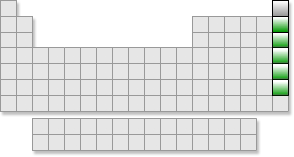|
|
Groups :Noble Gases |
About the Group
Let's look at the other side of the periodic table now. The group of elements at the far right of the table (Group 18) is known commonly as the noble gases. They are generally chemically inert. This means that they do not react with other elements because they already have the desired eight total s and p electrons in their outermost (highest) energy level. The elements in this group are helium, neon, argon, krypton, xenon, and radon. They are monatomic gases. These gases were not discovered until the last five years of the 1800s. They are extremely rare in nature, and none was known until helium was discovered to exist on the sun. In fact, the name of the element helium was derived from the Greek word Helios, used to refer to the sun. Chemical Properties Of the noble gases, only helium and neon are truly inert. The other noble gases will react on a limited scale under very specific conditions. Krypton will form a solid with fluorine, and xenon will form a variety of compounds with oxygen and fluorine. In the "Real" World The noble gases are used in industry in arc welding, to dilute the oxygen in deep-sea divers' gas tanks, and to fill light bulbs. Argon is used in arc welding and in common light bulbs, as it does not react with the metal at high temperatures. Helium is used for diluting the pure oxygen in deep-sea diving tanks because the helium has a low solubility in human blood. Helium is also used to inflate the tires of large aircraft, weather balloons, and blimps because it is nonflammable. Neon is used in sign tubing because it glows bright red when electricity is passed through it. Krypton and xenon are used in photographic flash units and in lighthouses, as running an electric current through either element generates a very bright light. |
 |
|||
| Next: Halogens |